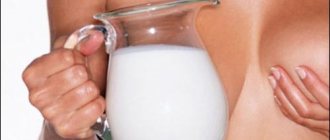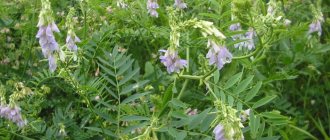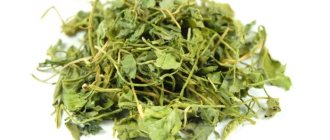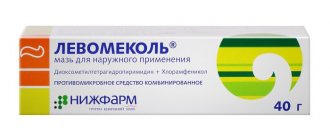How does sage affect breast milk production?
How sage affects the production of breast milk can be explained from a scientific point of view. This unique plant contains large quantities of phytoestrogens, similar to female sex hormones. And this component has long been used in medicine to alleviate the condition of women during menopause, with menstrual cycles accompanied by painful sensations, as a concomitant therapy in the treatment of infertility.
Not only can sage have a positive effect on a woman’s body in general, but it can also naturally reduce the amount of prolactin, which is responsible for the formation of breast milk.
When consuming sage, the amount of prolactin in the body gradually decreases, and the volume of milk produced decreases accordingly. But the hormonal levels do not suffer, and the woman’s well-being only improves. In addition, sage strengthens the immune system, relieves inflammation, and improves the functioning of the gastrointestinal tract.
Effect on lactation
If lactation needs to be stopped not urgently, sage will be a gentle, mild and effective remedy. The process of formation of breast milk when drinking tea or sage decoction subsides slowly.
When it's time to wean your baby, learn how to take the herb, continue breastfeeding, and slow down your lactation at the same time. While the amount of milk decreases, the baby will have time to wean himself off the breast, and everything will happen painlessly for mother and baby.
The plant is also useful if there is too much milk for the baby. Take pharmaceutical or self-prepared medicine to prevent congestion and mastitis in your breasts. Sage does not affect the quality of milk, so it can be taken without fear of harming the baby.
The herb acts not only as a means of stopping lactation. The substances prevent inflammatory processes in the mammary gland, which is very important for a young mother.
Stopping breastfeeding becomes a shock not only for the baby, the woman’s body also does not immediately rebuild itself. The calming effect of the medicinal plant will help a woman survive hormonal changes.
Lactation stops without the use of hormonal and herbal medications, but this process can take many months. The hormone estrogen suppresses the action of prolactin, which is responsible for milk production. Sage has a similar effect, but it cannot completely replace estrogen. The advantage of herbal remedies over hormonal drugs is the gradual action and the absence of hormonal shocks.
Methods of using sage to stop lactation
You can buy sage at any pharmacy, where it is offered in crushed form, in the form of tea bags. You can also buy sage oil, its extract or alcohol tincture.
The most common uses of sage to suppress lactation:
Sage oil
A product for external use, absolutely natural, although very concentrated. Contains a large number of biologically active substances. It acts more quickly than tinctures or decoctions. Allows you to avoid compaction of the mammary glands and inflammatory processes.
To prepare a compress, add a few drops of sage oil to 25 ml of base vegetable oil. Soak a small piece of damp cloth or gauze in the resulting solution, apply to the chest and leave for 30-60 minutes. To achieve the fastest results, such compresses can be applied more than once a day.
Sage oil is also allowed for oral use, but for this you need to be sure of the quality of the product used. In this case, you should take the product 4-5 drops four times a day.
You can simply rub sage oil into your chest.
Sage decoction
It's easy to prepare. 1 large spoon of dry medicinal herb is poured with 2 glasses of boiled water. The resulting mixture must be kept in a water bath or low heat for 10 minutes. It turns out a rich product, which should be taken 1 table at a time. spoon 4-5 times a day.
Sage infusion to stop lactation
To prepare the infusion, you need to pour 1 small spoon of crushed raw materials into a glass of boiling water. The composition is infused for about an hour, after which it is filtered. Divide a glass of infusion into 4 doses. Drink throughout the day, consuming 15-20 minutes before meals.
Sage in bags can be brewed like regular tea (1 bag per glass of boiling water). The resulting solution is divided into 2 or 3 doses and drunk throughout the day. Every morning you should brew a new portion of the product.
How to use sage to stop lactation
Sage during breastfeeding is a very gentle way to influence lactation. This method causes virtually no side effects for either the child or the mother. Salvia contains a natural phytohormone similar to estrogen. Therefore, it smoothly reduces the secretion of prolactin, which leads to a decrease in breast milk production.
Drink options and compresses
How to use the plant correctly? Both leaves and flowers of salvia are used in the form of extracts, infusions, oils and tea collections. They are prepared like this.
- Infusion. Three teaspoons of ground salvia greens are poured into 200 ml of boiling water, hermetically sealed and infused for half an hour.
- Decoction. Take the dried leaves and flowers of the plant in the amount of three teaspoons. Pour 200 ml of boiling water and heat in a container with water for 15 minutes. Then cool the broth, remove the remains of the plant and add water to a full glass.
- Sage oil. You can't drink the oil. It is used externally to heal cracked nipples, relieve pain, and has an antiseptic effect. For a compress, dissolve ten drops of oily salvia in half a glass of water. Dip a small piece of bandage or gauze, place it on the skin area, cover the surface of the bandage with cling film, and fix the compress with a warm cloth for one and a half to three hours.
- Tea. The leaves and inflorescences can be brewed as part of an herbal tea or as sage tea. Pour a teaspoon of dried salvia into a glass of boiling water and leave for five minutes. Drink hot.
How to use to reduce milk
How to drink sage during lactation? To reduce the production of breast milk during hyperlactation, you can drink 80 ml of infusion of leaves and inflorescences several times a day or 50 ml of hot tea with sage, also several times a day. You need to continue taking it for one or two weeks. If the amount of milk secreted decreases, then by the end of the week you need to stop taking Salvia.
Mothers often ask whether it is possible to feed a child while taking a medicinal plant? The taste of breast milk does not change when using sage, and the milk does not become harmful to the baby. Therefore, you can feed.
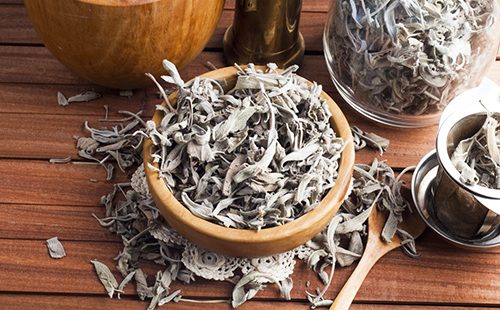
Additional measures to complete lactation
Since using sage is a long-lasting and gentle way to end breastfeeding, the method is especially effective after a year of breastfeeding. However, to complete lactation in this case it is better to rely on a set of measures. You can offer your mother the following six-point instructions for use.
- Infusion and tea. Regularly take 80 ml of infusion or drink sage tea three to four times a day.
- Compresses. Use sage oil daily to stop lactation as an adjuvant in the form of a compress.
- Avoid attachments. Latch the baby to the breast less often, until latching is complete.
- Do not pump your breasts. Express only when absolutely necessary, when there is a feeling of fullness and pain.
- Comfortable underwear. Choose a comfortable, non-squeezing bra.
- Mode. Distract and switch the baby's attention from the breast and feedings.
Having examined in detail how to take sage to stop lactation, we can confidently say that this is the optimal budget method that is not difficult to use. It is convenient at home, safe for both the child and the mother.
Contraindications for use
Despite the wide range of positive effects, the use of sage to stop lactation is contraindicated in some cases. In particular, it is not recommended to use this medicinal herb:
- People with severe forms of bronchitis and cough;
- Suffering from inflammation of the kidneys and urinary system;
- In case of malfunction of the thyroid gland;
- For those with low blood pressure.
- For epilepsy;
- During pregnancy.
It is not recommended to take sage in excessive doses or for more than 3 months. In such cases, irritation of the mucous membranes can occur.
How to use
This plant is produced in different forms - in herbal pharmacies you can buy dried leaves and inflorescences in cardboard boxes, sage herb to stop lactation in the form of disposable bags for brewing, essential oil, alcohol tincture and even sage extract in the form of tablets to treat a sore throat.
To stop lactation, infusions and decoctions of dry raw materials are used, less often - compresses with sage essential oil.
Most popular recipes:
- Sage infusion - 1 tsp. Pour dry herbs into a glass of boiling water, leave for an hour, then strain. Drink in 4-6 doses throughout the day. The infusion cannot be stored for more than a day; it is prepared daily. If the herb is packed in filter bags, you will need 2 of them per glass of water.
- Herbal infusion - consists of a complex of plants that stop lactation. Pour half a liter of boiling water over sage leaves (1 tsp), walnuts (1 tsp), mint (1 tbsp) and hop cones (1 tbsp), wrap or pour into a thermos, leave for about hours. Drink 50 g before meals 3-4 times a day.
- Sage decoction - a tablespoon of herb is poured into 2 tbsp. water, boil for 10 minutes, then cool slowly. The decoction is more concentrated than the infusion, so to stop lactation it is used in smaller quantities - 3-4 times 2 tbsp. spoons.
- Pharmacy tincture of sage with alcohol - used when the child no longer suckles. The product is diluted in water and drunk several times during the day, the daily dose is 60 drops of tincture.
- Oil compress - in addition to helping to complete lactation, successfully fights inflammation in the breast caused by stagnation of milk. To make it, sage essential oil is used in combination with any vegetable oil, for example, olive. Proportion: 1 teaspoon of vegetable oil – 2 drops of essential oil. The mixture can be made for several uses at once; it should be stored in a dark place under a lid. For a compress, slightly moisten the fabric with water, then sprinkle with a mixture of oils and wrap the chest for 0.5-1 hour. During the day, such wraps can be repeated several times.
You need to take sage in strictly prescribed doses. If you want to stop lactation faster, it is better to combine oral administration with the use of compresses, rather than increasing the concentration or increasing the volume of sage infusion you drink.
What is better for suppressing lactation – sage or tablets?
Tablets that stop breast milk production are suitable in cases where milk production needs to be stopped as soon as possible. However, it should be remembered that the use of such drugs is associated with certain risks to a woman’s health.
Sage is a milder and safer remedy for suppressing lactation. It not only helps reduce the volume of milk produced, but also improves immunity, keeps the mother feeling well and improves health.
If there are no contraindications to taking sage, and the necessary precautions are observed, then this medicinal herb will become a reliable and effective assistant in the process of completing breastfeeding. At the same time, the woman feels great and does not complain about her health.
Options for using sage during lactation
What may be required:
- natural sage oil;
- sage herb;
- water;
- walnut leaves;
- hop cones;
- pharmaceutical sage in filter bags;
- sage extract and tincture.
Sage oil for women
There is no clear framework for using the oil; it should be used until the desired effect is obtained. According to reviews, this takes up to 4 days. In order for the hormonal levels to change and breast milk to dry up painlessly, you need to take this medicine orally at least 4 times a day. Single dose – from 3 to 5 drops. It is also known about the external use of oil; such treatment protects against a dangerous phenomenon - lactostasis, and soothes inflammation. Combine cypress oil with sage oil - a couple of drops of each preparation. Also add mint and geranium oils - 3 drops of each preparation. Mix all this with 25 milligrams of base oil. Soak a gauze swab with the product and apply it to the problem mammary glands as a compress for an hour and a half.
Sage infusion recipe
Next, we will tell you how to brew sage to stop lactation in order to get exceptional benefits without side effects. So, take a teaspoon of herbs and pour a glass of boiling water. Leave the infusion for an hour and a half. Take the finished product a quarter glass before meals. A total of 4 doses per day are required.
Collection to reduce breast milk production
This herbal mixture includes sage and walnut leaves - a small spoon of each type of plant material, and you also need to add a large spoon of hop cones. Place all the herbs in a thermos and brew them with water. Two glasses of very hot water is enough. After soaking the infusion for an hour to an hour and a half, cool it. The finished herbal remedy is consumed three times a day, a quarter of a glass. It is advisable to keep the brewed mixture in the refrigerator.
Sage decoction recipe
A small spoon of herb is taken as a base, it is brewed by pouring boiling water over it. The total amount of water is 1 glass. Boil the sage for about 10 minutes over low heat, leave for half an hour. The filtered decoction should be consumed in a large spoon 4 times a day.
Sage in bags
How to brew bagged herbs - this information can be read on the packaging. Considering that in this form the plant gives minimal effect, you need to drink the tea for about 10 days. Every day it is advisable to take a whole glass of the drink in two doses.
Using sage tincture
To complete breastfeeding, more and more mothers are using sage-based tincture. It is sold in pharmacies. You just need to drop 30 to 60 drops of the product into water and drink this solution at least 3, maximum 6 times a day. Sage extract is also commercially available; you only need to dissolve 1 milliliter of liquid in any volume of water. Take the prepared product three times a day.
Of the recipes considered, the most effective is the last one. It is believed that the body absorbs herbal extracts and tinctures better than teas.
The use of sage to stop lactation
Breastfeeding mothers try to stop the production of breast milk in various ways. One of the effective methods is the use of sage.
Important tips for stopping breastfeeding
The need to stop lactation arises for various reasons: the mother’s health, the child’s refusal to breastfeed, etc. Pediatricians advise feeding a newborn with breast milk for at least 1 year.
The process of completing lactation can cause some problems, so you should listen to the recommendations:
- Weaning does not break the close relationship between mother and child. There comes a point when milk is replaced with vitamins and nutrients from other foods.
- A process initiated by the mother may be difficult for the child to perceive. It will take a lot of patience and time before the child's body gets used to the changes.
- Do not suddenly stop feeding. Gradually reducing the number of times your baby latches to the breast will benefit both of you. It is not recommended to bandage the breasts, as such actions can cause mastitis. To relieve discomfort, apply a cold compress or ice. You can express a small amount of milk if your breasts are very full. It is important not to provoke new milk production by such actions.
- It is recommended to skip 1 feeding and offer the baby to drink expressed milk from a bottle. You can also use a sippy cup or small cup.
- The baby can ask for the breast without feeling hungry. It is recommended to distract his attention with games or a walk.
- Breastfeeding mothers sometimes give breastfeeding to their baby, wanting to soothe him. You can improve your newborn's mood in other ways (hug, read a book, sing a song).
- To reduce the time. If the baby is attached to the breast for 5 minutes, stop feeding after 3 minutes. You can offer permitted fruit as a snack.
- The child drinks little, and the amount of milk does not decrease. In this case, it is recommended to reduce the amount of liquid consumed to a minimum. You should not take too hot a shower. To reduce pain, it is recommended to apply chilled cabbage leaves to the chest.
- You should teach your child to fall asleep while eating. After lunch, you can take a walk outside so that your newborn learns to fall asleep on his own. When putting your child to bed in the evening, you can turn on slow music, read a fairy tale, and put your favorite toys in bed. After some time, the newborn will get used to the new ritual.
- Wean your child off night snacks and set him up for uninterrupted sleep. If he wakes up at night, you should not give him the breast. It is best to rock the baby in your arms and sing a lullaby. You can offer to drink water.
- Once you are determined to stop lactation, you cannot give up when you hear a baby crying. It is recommended to be close to the child and try to comfort him. The mother's confidence and calmness are transferred to the child.
The child may not be ready for drastic changes. You should not start this process if the newborn is sick. If there is no urgent need, weaning can be postponed for a while.
Pros and cons of sage
Sage is used more often than other plants during breastfeeding due to the large number of active components. It includes:
- essential oil, the main ingredients of which are pinene, rhodine, cineole, camphor and thujone;
- flavonoids;
- tannins;
- tannins;
- organic acids;
- carotene;
- resinous compounds;
- vitamins (A, B, C, PP);
- minerals (iron, zinc, sodium, potassium, magnesium, calcium).
Products prepared from this plant are used for the following purposes:
- to reduce breast milk production;
- disinfection;
- strengthening the stomach;
- reducing mucus accumulation;
- reducing sweating;
- accelerated scar healing.
The plant has anti-inflammatory, expectorant and astringent effects. It promotes conception and prevents the development of cancer. The body's protective properties are strengthened, and a feeling of calm appears due to the sedative properties of the plant.
The anti-lactation effect of sage is based on the phytoestrogen present in its composition. The use of this plant promotes the active production of estrogen. A high content of this gene in the blood leads to a sharp drop in prolactin levels. Without this hormone, milk production is impossible.
Products prepared from the plant are harmless (in the absence of contraindications). Disadvantages include the appearance of negative symptoms due to long-term use of herbal remedies. You can drink sage only after consulting a specialist, because in some cases unpleasant symptoms occur:
- stomach ache;
- noise in ears;
- increased heart rate;
- dizziness;
- nausea.
If such consequences occur, you should stop using herbal remedies.
Rules for taking to reduce lactation
Sage to stop lactation (how to take):
- The need to stop milk production may occur even if this product is the main source of nutrition for the child. In this case, the doctor prescribes special medications, and herbal infusions will only be an additional remedy.
- If the baby needs breastfeeding only at night, there is no need to quickly stop lactation. The plant will help to gradually reduce milk production and wean the newborn from the breast.
When using herbal remedies to suppress lactation, you should not expect quick results. The hormone contained in the plant does not act as effectively as estrogen.
Rules for taking herbal remedies:
- The procedure should begin after the child reaches 1 year, because at this age it is easier for him to switch to other foods.
- The course should begin after some feedings have been replaced with complementary foods.
- The amount of fluid consumed (including herbal infusions) should be halved. It is not recommended to drink drinks that are too hot.
- Once you start using herbal remedies, you should not breastfeed your baby. It is recommended to express milk (not often). First, perform this procedure after 1 day, then after 3 days.
- Compresses help relieve fever resulting from inflammation. If there is no improvement, you should seek medical help.
It is recommended to lead an active lifestyle and exercise, as increased sweating reduces milk production. How many days the final process will last depends on the individual characteristics of the female body.
Sage is also used in its pure form during lactation. The crushed plant is added to fruit or vegetable juice. The effect of this plant will be noticeable within 4 days. Milk will stop flowing in, its production will tend to decrease.
Decoctions
Decoctions help get rid of the feeling of fullness in the chest and prevent the appearance of lumps in it. This remedy is used to gradually wean the baby from the breast.
We recommend that you read: Use of sage during pregnancy
Ingredients:
- leaves of the plant - 7 g;
- water - 250 ml.
Cooking technology:
- Chop the leaves, add boiling water and place in a water bath.
- Cook covered over low heat for 10 minutes.
- Remove from heat, wrap in a towel and let steep for 2 hours.
- Strain the finished drink through several layers of gauze.
It is recommended to take 1 tbsp up to 4 times a day. l. before eating. The product not only reduces the amount of milk and eliminates breast discomfort, but also reduces pain during menstruation.
The decoction is useful not only for internal use. It can be used to apply compresses to the nipple area to reduce the amount of milk produced, but this method requires long-term use.
The infusion also helps solve the problem. To prepare it, pour boiling water (½ l) over the herb (1-2 tbsp) and let it brew in a thermos for 20 minutes. Once cooled to room temperature, the drink can be taken orally. This infusion can replace part of the liquid consumed during the day.
You can prepare the grass yourself at the beginning of flowering and in September. The flowering tops of the plant and leaves are used. In pharmacies, the herb is sold dried or in the form of tablets or capsules. Consuming them during breastfeeding will help quickly complete milk production. Before taking the tablets, it is recommended to read the instructions.
Tinctures for breastfeeding
You can buy a ready-made tincture in pharmacies, but due to the alcohol content, you should not put the baby to the breast after consuming it. To prepare the product you will need the following ingredients:
- alcohol tincture - 50-60 drops;
- chilled boiled water - 1 glass.
Combine the components and take the resulting product throughout the day.
Sachets
The herb can also be sold in bags. This form is convenient to use. The drink infuses faster because the leaves in the bags are crushed. The disadvantage is the low efficiency of the drink compared to decoction and oil.
Before using the plant, you should learn how to brew sage to stop lactation:
- Empty your breasts (feed your baby or express milk).
- Pour boiling water (1 glass) over the grass (2 filter bags) and let it brew.
- Use when cooled.
The maximum daily intake is 500 ml. It is recommended to drink the drink in small portions throughout the day. As a result of taking it, the heaviness in the chest will gradually disappear, because the amount of milk produced will decrease.
The duration of use is about 1 or 2 weeks. To get quick results, it is recommended to combine tea with compresses and oil.
You should carefully monitor your condition and stop taking the medication after milk production has completely stopped.
The plant has a bitter taste, so it is recommended to add honey, sugar or other sweeteners to drinks.
Extracts
The extract is more effective than alcohol tincture. The substance should be dissolved (1 ml) in a small amount of water and taken 3 times a day. Care must be taken not to overdose.
We recommend that you read: Corn during breastfeeding
Compresses for breastfeeding
Such procedures will not eliminate lactation, but will help prevent the appearance of lumps in the breast. In this case, both the plant itself and the oil made from it are used. A few drops of the substance should be applied to cotton wool or gauze and applied to the breast, without touching the nipples and areolas.
To prepare a more effective product, you will need the following ingredients:
- sage oil - 2 drops;
- mint oil - 2 drops;
- geranium oil - 2 drops;
- cypress oil - 2 drops;
- vegetable oil - 25 g.
Mix all ingredients. Moisten gauze in the resulting mixture and apply to the area where inflammation has formed. The compress should be kept for about 2-3 hours. The effectiveness of compresses is due to the content of a large number of phytohormones in essential oils, which affect the production of prolactin. This hormone is responsible for milk production.
Compresses are a preventative against various diseases of the mammary glands.
If you have lumps, it is recommended to consult a mammologist before using homemade products. In some cases, emergency medical care is required, including surgery.
Oils
Sage oil is widely used to stop lactation, since this composition contains the largest amount of useful substances. It is recommended to take 5 drops 4 times a day. The average duration of use is 4 days. To reduce pain, it is recommended to use compresses. Apply a few drops of oil to cabbage leaves and apply to the mammary glands.
Possible contraindications
The use of sage to reduce lactation is contraindicated in the following cases:
- epilepsy;
- diseases of the thyroid gland, accompanied by a weakening of its functions;
- pyelonephritis;
- high blood pressure;
- pregnancy;
- chronic bronchitis, cough in the acute stage;
- inflammatory diseases of the reproductive system;
- the presence of tumors (both malignant and benign);
- remission after cancer of the uterus and mammary glands;
- individual intolerance.
A nursing woman taking herbal preparations should regularly check the baby's skin for allergic reactions. The duration of use should not exceed 3 months, since the phytoestrogens that make up the plant gradually accumulate in the body and can cause severe poisoning.
Dr. Komarovsky
Advice from E. O. Komarovsky (pediatrician) on safe weaning of a child:
- Separate mother and child for 2-3 days. The option is complex (morally) and is therefore rarely used.
- Limit the amount of liquid.
- Reduce sucking time as much as possible (distract the child, play with him).
- Don't pump.
- Be active in sports.
- Avoid consuming foods that stimulate lactation (for example, beer).
You can worsen the taste of milk by including garlic or other similar products in your diet. The use of herbs to solve this issue is a more gentle method, because...
Taking medications affects your health. The chemical composition of the drugs negatively affects the condition of the heart, kidneys, liver and gastrointestinal tract.
The pills also affect a woman’s emotional state, causing fatigue and depression.
Source: https://alltravnik.ru/travy/shalfej-i-laktaciya
Sage contraindications
The effect of sage is safe and does not have negative consequences in the form of lactostasis, for example, as happens when bandaging the breast and reducing fluid intake.
But there are certain contraindications to the use of this folk remedy:
- The woman has endometriosis;
- Hypertension. If a woman suffers from high blood pressure, then the use of the medicinal plant should be very careful;
- Disorders of the thyroid gland. In this case we are talking about its reduced function;
- Presence of acute kidney disease. In this case, sage is prohibited;
- Epilepsy disease;
- Pregnancy. When a mother finds out that she is pregnant while breastfeeding her baby, it is not recommended to stop lactation with the help of sage.


